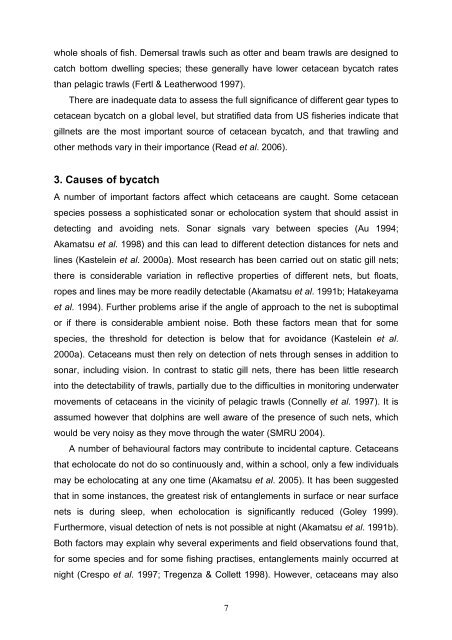The Animal Welfare Implications of Cetacean Deaths in Fisheries
The Animal Welfare Implications of Cetacean Deaths in Fisheries
The Animal Welfare Implications of Cetacean Deaths in Fisheries
You also want an ePaper? Increase the reach of your titles
YUMPU automatically turns print PDFs into web optimized ePapers that Google loves.
whole shoals <strong>of</strong> fish. Demersal trawls such as otter and beam trawls are designed to<br />
catch bottom dwell<strong>in</strong>g species; these generally have lower cetacean bycatch rates<br />
than pelagic trawls (Fertl & Leatherwood 1997).<br />
<strong>The</strong>re are <strong>in</strong>adequate data to assess the full significance <strong>of</strong> different gear types to<br />
cetacean bycatch on a global level, but stratified data from US fisheries <strong>in</strong>dicate that<br />
gillnets are the most important source <strong>of</strong> cetacean bycatch, and that trawl<strong>in</strong>g and<br />
other methods vary <strong>in</strong> their importance (Read et al. 2006).<br />
3. Causes <strong>of</strong> bycatch<br />
A number <strong>of</strong> important factors affect which cetaceans are caught. Some cetacean<br />
species possess a sophisticated sonar or echolocation system that should assist <strong>in</strong><br />
detect<strong>in</strong>g and avoid<strong>in</strong>g nets. Sonar signals vary between species (Au 1994;<br />
Akamatsu et al. 1998) and this can lead to different detection distances for nets and<br />
l<strong>in</strong>es (Kastele<strong>in</strong> et al. 2000a). Most research has been carried out on static gill nets;<br />
there is considerable variation <strong>in</strong> reflective properties <strong>of</strong> different nets, but floats,<br />
ropes and l<strong>in</strong>es may be more readily detectable (Akamatsu et al. 1991b; Hatakeyama<br />
et al. 1994). Further problems arise if the angle <strong>of</strong> approach to the net is suboptimal<br />
or if there is considerable ambient noise. Both these factors mean that for some<br />
species, the threshold for detection is below that for avoidance (Kastele<strong>in</strong> et al.<br />
2000a). <strong>Cetacean</strong>s must then rely on detection <strong>of</strong> nets through senses <strong>in</strong> addition to<br />
sonar, <strong>in</strong>clud<strong>in</strong>g vision. In contrast to static gill nets, there has been little research<br />
<strong>in</strong>to the detectability <strong>of</strong> trawls, partially due to the difficulties <strong>in</strong> monitor<strong>in</strong>g underwater<br />
movements <strong>of</strong> cetaceans <strong>in</strong> the vic<strong>in</strong>ity <strong>of</strong> pelagic trawls (Connelly et al. 1997). It is<br />
assumed however that dolph<strong>in</strong>s are well aware <strong>of</strong> the presence <strong>of</strong> such nets, which<br />
would be very noisy as they move through the water (SMRU 2004).<br />
A number <strong>of</strong> behavioural factors may contribute to <strong>in</strong>cidental capture. <strong>Cetacean</strong>s<br />
that echolocate do not do so cont<strong>in</strong>uously and, with<strong>in</strong> a school, only a few <strong>in</strong>dividuals<br />
may be echolocat<strong>in</strong>g at any one time (Akamatsu et al. 2005). It has been suggested<br />
that <strong>in</strong> some <strong>in</strong>stances, the greatest risk <strong>of</strong> entanglements <strong>in</strong> surface or near surface<br />
nets is dur<strong>in</strong>g sleep, when echolocation is significantly reduced (Goley 1999).<br />
Furthermore, visual detection <strong>of</strong> nets is not possible at night (Akamatsu et al. 1991b).<br />
Both factors may expla<strong>in</strong> why several experiments and field observations found that,<br />
for some species and for some fish<strong>in</strong>g practises, entanglements ma<strong>in</strong>ly occurred at<br />
night (Crespo et al. 1997; Tregenza & Collett 1998). However, cetaceans may also<br />
7
















